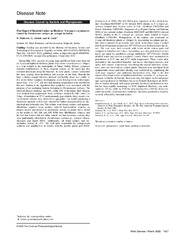Приказ основних података о документу
First report of bacterial canker on blueberry (Vaccinium corymbosum) caused by Pseudomonas syringae pv. syringae in Serbia
| dc.creator | Zlatković, Nevena | |
| dc.creator | Aleksic, Goran | |
| dc.creator | Gašić, Katarina | |
| dc.date.accessioned | 2023-07-12T09:32:16Z | |
| dc.date.available | 2023-07-12T09:32:16Z | |
| dc.date.issued | 2022 | |
| dc.identifier.issn | 0191-2917 | |
| dc.identifier.issn | 1943-7692 | |
| dc.identifier.uri | https://plantarum.izbis.bg.ac.rs/handle/123456789/652 | |
| dc.description.abstract | During May 2021, necrosis of young twigs and flower buds were observed on two-year-old highbush blueberry plants (Vaccinium corymbosum) cv. Draper, in a 1 hectare orchard in the municipality of Šabac, Serbia. Disease symptoms included reddish-brown to black irregularly shaped cankers developing on the shoot tips that extended downwards along the branches. In some plants, cankers surrounded the stem, causing shoot-tip dieback and necrosis of the buds. Beneath the bark, a distinct margin between diseased and healthy tissue was visible. A few weeks before symptoms development, seven freezing events with temperature from -3°C to -1°C, and five near-freezing temperatures were recorded in this area, leading to the hypothesis that symptoms were associated to the presence of ice nucleating bacteria belonging to Pseudomonas syringae. The observed disease incidence was 80%, while 10% of the plants died. Bacteria were isolated from symptomatic tissue on King’s medium B (KB). After 2 to 3 days of incubation at 27°C, predominantly grey-whitish, shiny, round, convex bacterial colonies were observed on agar plates. Ten isolates producing a fluorescent pigment on KB were selected for further characterization by biochemical and molecular tests. The isolates were Gram, oxidase and arginine-dihydrolase negative, levan positive, induced hypersensitive response on tobacco leaves and showed no pectinolytic activity on potato slices. Based on the results of API 20E and API 20NE tests (BioMerieux, France), and the fact that isolates did not utilize tartrate nor had tyrosinase activity, they were preliminarly identified as Pseudomonas syrinage pv. syringae (Braun-Kiewnick and Sands 2001). Additionally, all tested isolates had ice-nucleation activity at -5°C. The syrB gene responsible for syringomycin synthesis, was amplified in all isoaltes with the specific primer pair B1/B2 (Sorensen et al. 1998). The 16S rRNA gene sequences of five selected isolates (GenBank MZ410287 to 91) showed 100% identity to P. s. pv. syringae isolated from Prunus avium in United Kingdom (GenBank CP026568) and France (GenBank LT962480). Sequences of gyrB gene (Sarkar and Guttman 2004) of two selected isolates (GenBank MZ420633 and MZ420634) showed 98,44% identity to the P. s. pv. syrinage strain isolated in France (GenBank LT962480). Pathogenicity of the isolates was confirmed on 2-year-old blueberry plants cv. Draper, by inoculating two plants per isolate. One-cm long wounds were made on branches using a scalpel and 20 µl of bacterial suspension (106 CFU/ml) was infiltrated into the tissue. The cuts were then covered with moist sterile cotton pads and wraped in parafilm for 3 days. Inoculation was also performed on two leaves per plant by needleless syringe infiltration (106 CFU/ml). Sterile distilled water was used as a negative control. Plants were maintained in greenhouse at 27°C day and 15°C night temperature. Three weeks after inoculation, the inoculated branches and leaves developed necrosis, leaves spots and cankers respectively, resembling the natural infection. Symptoms were not observed on the control plants. Bacteria were reisolated from symptomatic tissue and their identity was confirmed by amplifying the syrB gene sequence and additional biochemical tests. This is the first report of bacterial canker of highbush blueberry caused by P. s. pv. syringae in Serbia. In Europe, there was only one report on Pseudomonas spp. causing disease on blueberry leaves in Poland (Kaluzna et al. 2013). Due to market demands and export potential, blueberry production in Serbia has been rapidly increasing. In 2015, highbush blueberry was cultivated on 220 ha, while in 2020 the area increased to 1899 ha. However, under favourable environmental conditions, blueberry production might be severely affected by bacterial canker. | sr |
| dc.language.iso | en | sr |
| dc.publisher | American Phytopathological Society | sr |
| dc.relation | info:eu-repo/grantAgreement/MESTD/inst-2020/200010/RS// | sr |
| dc.rights | openAccess | sr |
| dc.rights.uri | https://creativecommons.org/licenses/by-nc-nd/4.0/ | |
| dc.source | Plant Disease | sr |
| dc.subject | Prokaryiotes | sr |
| dc.subject | small fruits | sr |
| dc.subject | pathogen detection | sr |
| dc.title | First report of bacterial canker on blueberry (Vaccinium corymbosum) caused by Pseudomonas syringae pv. syringae in Serbia | sr |
| dc.type | Информативни прилог | sr |
| dc.rights.license | BY-NC-ND | sr |
| dc.citation.epage | 1057 | |
| dc.citation.issue | 3 | |
| dc.citation.rank | M21 | |
| dc.citation.spage | 1057 | |
| dc.citation.volume | 106 | |
| dc.type.version | publishedVersion | sr |
| dc.identifier.doi | 10.1094/PDIS-07-21-1395-PDN | |
| dc.identifier.fulltext | http://plantarum.izbis.bg.ac.rs/bitstream/id/2704/bitstream_2704.pdf | |
| dc.identifier.scopus | 2-s2.0-85126261440 | |
| dc.identifier.wos | 00082308810003 |


